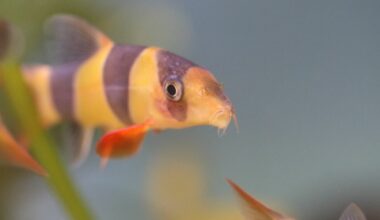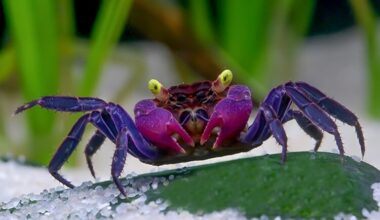Crystal Red shrimp are an eye-catching species that appeal to a wide range of aquarists. With their beautiful pattern and bright colors, they add a splash of color to pretty much any tank!
But keeping these shrimp is a bit trickier than it seems. In order to thrive, they require some specific conditions that are a little out of the ordinary.
This guide will teach you the fundamentals of Crystal Red shrimp care. It covers water parameters, diet, tank setup, size, breeding, and much more.
Table of Contents
Species Summary
A product of selective breeding, the Crystal Red shrimp (Caridina cantonensis) is often considered the crowning jewel of all dwarf shrimp species. Because they don’t occur in nature, these freshwater shrimp are highly sought after in the pet trade.
If you’re lucky enough to get your hands on one, you must work hard to keep them healthy. This shrimp has gone through years of selective breeding. As a result, it’s not as hardy as other species.
It’s believed that this unique shrimp came from a single mutation of a black Bee shrimp! While we can use the Bee shrimp as a general guide, The Crystal Red shrimp is a unique species in its own right.
Lifespan
The typical Crystal Red shrimp lifespan is only around 18 months when kept in captivity. These critters don’t live very long in an aquarium setting.
Author Note: This lifespan is only possible if you provide them with pristine care. This shrimp’s sensitivity to poor water conditions could lead to an early death if you’re not careful.
Appearance
The Crystal Red shrimp is a beautiful invertebrate that injects a ton of color into your tank! The species looks like any other type of freshwater shrimp when it comes to body shape. They have a strong tail with swimmerets, multiple legs, and several antennae.
But it’s the color that sets the shrimp apart.
These shrimp can vary widely in terms of color patterns. However, most will feature shades of vibrant red and bright white. These colors can be arranged in stripes or take on a more organic pattern.

There are so many pattern variations that these shrimp have a grading system. The different grades reflect the amount of white the shrimp have. More white is desirable, which ultimately impacts purchase price.
On the “lower” end, you have Grade C shrimp. They are mostly covered in red and might have a few spots of white here and there. Grades A and S feature the most even striping.
On top of the scale, there’s Grade SSS shrimp have the most white coloration with subtle stripes or spots of red.
Males and females look very similar. In fact, the only real way to tell the difference is to look at their size and abdomen. Females are also noticeably larger and have a deeper abdomen and wider tail to care for their young.
Average Size
Crystal Red shrimp are only 1 to 1.5 inches long as full-grown adults. This species is considered a dwarf shrimp, and with such a tiny size it’s easy to see why!
Author Note: Because of their length it’s actually quite hard to tell the difference between a large specimen and a smaller one. This is why it’s important to analyze breeding methods when purchasing them (you can’t rely on the eyeball test alone).
Crystal Red Shrimp Care
Crystal Red shrimp care is actually a rather big undertaking. This is something that surprises many potential owners at first, but there’s a very simple reason why this is the case.
Years of selective breeding have made this species very sensitive to poor water conditions. As a result, they require a carefully managed environment to thrive.
The key is having a strong understanding of what the shrimp needs as you progress through ownership. This will serve as your guiding principle when providing care.
Below are some important guidelines you need to follow:
Tank Size
A large aquarium is not necessary for Crystal Red shrimp. They do just fine in small nano-style tanks.
You can keep a modest colony in a tank as small as 5 gallons.
However, we recommend keeping them in a tank that can hold at least 10 gallons. Larger tanks tend to be easier when it comes to stabilizing and maintaining tank conditions. With this species’ sensitivity, you might as well take all the help you can get!
Crystal Red Shrimp Water Parameters
While Crystal Red shrimp don’t live in the wild, many aquarists use its ancestor for guidance. The Bee shrimp comes from mountain river streams throughout China and Vietnam where the waters are on the cooler side. The streams are also clean, relatively neutral, and have low hardness.
Getting living conditions just right is important. Luckily, there is some wiggle room for the shrimp.
What’s truly important is keeping the tank free of ammonia and nitrates. Crystal Red shrimp have a very low bioload, but tank mates can sour the water very quickly. You must monitor conditions regularly and perform 30 percent water changes every week to keep things stable.
Aim for the following water parameters to create a healthy environment for your shrimp.
- Water Temperature: 62°F to 78°F (above 70 degrees is recommended)
- pH levels: 5.8 to 7.4
- Water Hardness: 0-4 kH
Setting Up The Rest Of Their Habitat
The best kind of environment for Crystal Red shrimp is one that’s modeled after densely planted forest streams.
These shrimp do best when surrounded by natural vegetation. Not only do plants act as a source of food, but they also provide shelter.
This species is a favorite for aquascaping tanks. They live harmoniously with plants and will feed off any plant detritus and aquarium algae they generate.
Utilize several plant species to keep things interesting. Add tall plants in the rear, fine-leafed plants in the middle of the tank, and plenty of shorter ground-cover plants. These shrimp don’t need a ton of open swimming space, so get creative with your underwater landscape.
There are no hard requirements in terms of substrate or rocks, but Crystal Red shrimp tend to do better in the sand. They spend most of their time at the bottom of the tank, so having soft sand as a substrate is always best.
Author Note: Beyond decorations, you’ll need a sponge filtration system. Sponge filters are safer for the shrimp and any babies they may have. Make sure you let the tank cycle with biological filtration before adding shrimp.
The good news is that these shrimp don’t produce a ton of waste. Any standard filter rated for the tank should work fine.
Common Possible Diseases
On top of their ammonia sensitivities, Crystal Red shrimp can experience several diseases and infections.
Bacterial infections can wreak havoc on a shrimp’s health. Usually caused by poor water conditions, the infection will cause internal bleeding, inflammation, and other painful symptoms. The problem with bacterial infections is that they often go unnoticed until it’s too late.

Fungi can take hold of your shrimp, too. There are several types of fungi that harm shrimp. Usually, they appear as a white fuzzy film over the shrimp’s body.
Finally, there are parasitic infections. Parasitic nematodes, such as the Scutariella Japonica can grow in the shrimp’s head! Once they infiltrate the shrimp’s body, they can grow, reproduce, and thrive. The same goes for Vorticella, another common parasite that looks like fungal growth!
Most of these diseases are perfectly treatable, but it’s best to consult with a vet if you’re not sure what medicines to use. Do not use any medicines that have copper in them, as the metal is harmful to inverts like the Crystal Red shrimp.
Food & Diet
This tiny species is a scavenging omnivore that’s very low-maintenance when it comes to food. In fact, managing their diet is one of the easiest parts of Crystal Red shrimp care.
They’ll spend most of their day scouring the tank in search of algae, plant detritus, and microorganisms to eat! They’re great filter feeders that can catch floating food as they swim.
Despite their scavenging nature, it’s important to feed these shrimp daily. You can provide commercial shrimp food. It usually comes in the form of powder or pellets. Algae wafers work well, too.
If you want to go the natural route, you can provide pieces of blanched vegetables as well. The shrimp love zucchini, broccoli, peas, romaine lettuce, and cucumbers.
Behavior & Temperament
You don’t have to worry about aggression with the Crystal Red shrimp. This is a very peaceful species that gets along with any non-aggressive tank mate. They do well with other shrimp and can even cohabitate with fish!
Staying at the bottom of the tank, these shrimp won’t pay any attention to what’s going on higher up in the water column. They’ll spend their days searching for food. You might see them crawling over the substrate, investigating plants, or grouping up with other shrimp.
Tank Mates
Finding suitable tank mates for this species isn’t always easy. The biggest challenge you’re going to face is finding tank mates that won’t try to eat the shrimp.
Thanks to their small size and bright coloration, they’re a target for larger fish. Avoid any fish that could eat the shrimp. You can try to keep the shrimp with other dwarf shrimp, such as Bamboo or Amano shrimp. However, you need to ensure that whatever inverts you keep like the same water conditions.
Most aquarists will keep Crystal Red shrimp on their own. This is the safest way to raise the shrimp without worrying about compatibility issues (especially if you’re interested in breeding).
Crystal Red shrimp do just fine in a single-species aquarium. As long as you have a sizable group, they’ll be happy.
Author Note: One of the most common tank mate questions is if Crystal Red shrimp and Cherry shrimp are compatible. This is not a problem, although they might end up with less aesthetically-pleasing offspring if they mate.
Breeding
The cool thing about Crystal Red shrimp is that they’re easy to breed in captivity. While they don’t have a long lifespan, these shrimp often breed without intervention. This keeps your collection replenished without having to purchase new specimens!
These shrimp are more inclined to breed when temperatures are around 78 degrees Fahrenheit. Feed them well and the females should start swelling up with eggs in no time. She’ll then release pheromones in the water to tell males that she’s ready to breed!
Females will lay eggs and carry them under her abdomen. She’ll use her swimmerets to constantly fan them.
It takes about 30 days for the eggs to hatch. Make sure you remove any fish and apply a sponge to the filter to increase hatchling survival rates. You can provide powdered shrimp food to feed them. Though, they will get good at scavenging pretty quickly.
Baby Crystal Red shrimp will grow up fast. It only takes about four or five weeks to reach adulthood. By that point, they’ll be able to breed.
Wrapping Up
Crystal Red shrimp care can seem challenging at first, but once you know the basics it becomes a lot easier. As long as you’re informed and consistent everything will be just fine.
We highly recommend giving these shrimp a shot. Their beauty is unmatched and the aesthetic effect they have on a freshwater aquarium is something you need to see in person!

